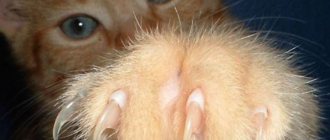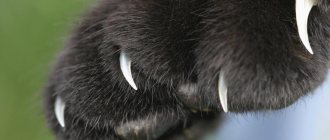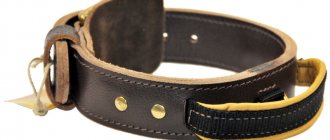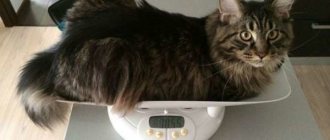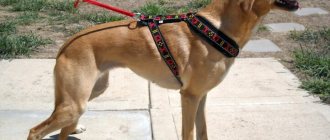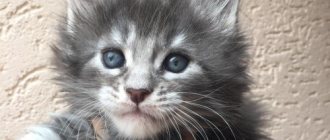When you bring a small kitten into your home, you need to be prepared for the fact that the occurrence of a problem such as fleas is simply inevitable. And it is not at all necessary for the animal to go outside for this; parasites can overcome even the most indoor pets. The owner himself can bring pests into the apartment on shoes or clothes. The small size of the body and the ability to jump well make it possible for bloodsuckers to enter a person’s home through the same doors, windows and cracks in the floors. Therefore, it is very important to choose an effective means of protection for your furry baby. An example of this would be a flea collar for kittens.
Features of the protective accessory
The great demand among consumers for flea collars is explained by many advantages:
- Effective protection against fleas. To protect your kitten from parasite attacks, you just need to put on an anti-parasitic collar in a timely manner.
- Wide spectrum of action. These types of accessories are also universal. There is a collar for kittens against fleas and ticks; it is also effective against lice and lice.
- Long period of protection. The validity period of the antiparasitic accessory varies between 2-7 months.
- Affordable price. The initial cost of a flea collar for cats is about 50 rubles. If we consider more expensive models, then taking into account long-term use, the cost of such a means of protection turns out to be very acceptable.
- Simple and convenient way to use.
But, like any means of protection, a flea collar for kittens has its drawbacks:
- Flea collars for cats only affect adult parasites; they have no effect on pest larvae and eggs.
- An incorrectly selected safety harness model can negatively affect the kitten’s health. A similar effect is often observed when using non-certified products.
- An incorrectly worn device often causes discomfort. There is also a high probability of an allergic reaction in the animal.
Flea collars
Antiparasitic collars can have both a deterrent and destructive character. Therefore, you need to know how and when to put a flea collar on a kitten. After all, models designed for adult animals are not suitable for use by children.
Products with smell
Destructive agents are made in the form of a rubber strip that releases an insecticidal substance. Under the influence of active components, parasites become lethargic, less mobile and die after a while. Intended for kittens older than six months. The validity period of such devices is no more than 7 months.
Do not use the collar immediately after treating the kitten with antiparasitic drops or shampoo. The break after interaction with the protective drug should be at least 10 days.
Bio collars
Bio flea collars for kittens are an ideal option for protection against parasites. They do not contain chemical insecticides and are based on natural essential oils of wormwood, eucalyptus, rosemary, and cedar. Therefore, you can put a flea collar on your kitten when it reaches two months of age. In addition, the natural composition has a beneficial effect on the animal’s fur and skin.
Such models are used only for kittens that are not infected with fleas. Otherwise, the effect will not be achieved. Therefore, when an animal is infested with parasites, it is necessary to remove fleas from the kitten. The prolonged effect of the bio product is about 4 months.
Advantages and disadvantages of flea collars
Different types of collars have advantages of use that are especially necessary for cats that walk outside and then return home:
- Such an anti-flea product ensures that the cat will not bring insects from the street into the house, which is especially important for residents of lower floors and country houses; when going for a walk, the cat should always wear a collar;
- Repellents reduce the activity of parasites by acting on their nervous system, and the cat simply shakes off the flea or tick until it tries to attach to the skin;
- There are almost safe varieties that can be used for kittens and pregnant cats, but when purchasing, you need to carefully look at the instructions at what age it can be worn;
- Such collars indicate that such a walking cat has an owner, so strangers see that the animal is not homeless.
Disadvantages of this protection:
- Only adult individuals are destroyed or scared away, and the eggs continue to be in the fur until the moment of hatching and only then leave;
- To increase the effectiveness of protection, before putting on the collar, you need to treat with drops or anti-flea shampoo;
Flea shampoo for kittens - The effectiveness of the impact can be visible only after a few days, and it is impossible to predict it, because it depends on a large number of factors (animal health, environment and weather conditions);
- There is a possibility that an overly active cat may get caught in the collar when climbing a tree;
- They have a toxic effect and can cause poisoning not only of insects, but also of the animal itself (this often happens when the model is incorrectly selected according to age or is of poor quality, a fake).
What you should know
Flea collars for kittens
Before purchasing an anti-parasitic accessory, you must:
- Find out from how many months a kitten can wear a flea collar.
- It is necessary to put the product on correctly: it should not squeeze the pet’s neck, and vice versa, it should not sit too loosely. There should be a gap of 2 fingers between the neck and the accessory.
- Excess tape is cut off, leaving 5 cm to allow the device to be loosened as the animal grows.
- You should periodically check whether the kitten is comfortable wearing the anti-parasitic device. It is also necessary to monitor the condition of the skin for allergic reactions.
- An accessory that has not lost its protective properties and odors should be sealed when removed.
- When using an antiparasitic device, it is contraindicated to eat, drink or smoke.
- After contact with the antiparasitic product, you must wash your hands thoroughly.
Below is an overview of the most popular models of anti-parasitic collars for kittens.
How to use collars correctly, restrictions and contraindications
To activate substances in the insecticidal collar that are toxic to insects, you need to stretch it a little until a white coating appears, and then attach it to your pet’s neck. The biological collar does not require stretching and can be immediately put on the cat. If the collar is too long, then the excess part is simply cut off. The ultrasonic collar needs to be turned on, and sometimes you also need to set the desired mode.
The collar is worn correctly if two fingers fit under it (1–1.5 cm)
Contraindications and restrictions
Insect collars are not recommended:
- sick and weakened animals;
- animals prone to allergies;
- pregnant and lactating cats;
- kittens.
You also need to remember that any, even the healthiest cat, may experience individual intolerance to the active ingredients of the collar, characterized by:
- irritation and redness of the skin,
- lacrimation,
- excessive salivation,
- vomiting,
- hanging temperature.
The collar should be removed immediately and the pet taken to a veterinarian. Cats should never chew or lick their collar, as this could cause poisoning.
People who have had contact with a cat wearing a collar must wash their hands with soap, because the chemicals in its composition can be harmful to health. Under no circumstances should the collar fall into the hands of children.
Video: how to use a collar correctly
Hartz
Hartz flea collar for kittens
Anti-flea accessories from an American manufacturer occupy a leading position in the list of antiparasitic products. They have a long-lasting effect (7 months). The devices are also distinguished by good moisture resistance, a pleasant fresh smell and a safe lock that allows you to quickly remove the collar if necessary. Accessories can be used by little pets over three months of age. The price range varies depending on the region within 200-300 rubles.
The Hartz collar is a very effective flea control product for cats. We started using it when the kitten was 3 months old. Now our favorite is very big, but he continues to wear Hartz to this day. We change the strap periodically, so we don’t have any problems with parasites.
The Leopard collar is a domestically produced product with an affordable price (from 45 rubles). Treated with a composition whose active ingredient is fipronil. The manufacturer recommends using the product for kittens starting from 2 months of age.
A very convenient little thing for solving such a problem as fleas on a kitten. I recommend.
Which flea collars are best for kittens and at what age can they be worn?
When you bring a small kitten into your home, you need to be prepared for the fact that the occurrence of a problem such as fleas is simply inevitable. And it is not at all necessary for the animal to go outside for this; parasites can overcome even the most indoor pets. The owner himself can bring pests into the apartment on shoes or clothes. The small size of the body and the ability to jump well make it possible for bloodsuckers to enter a person’s home through the same doors, windows and cracks in the floors. Therefore, it is very important to choose an effective means of protection for your furry baby. An example of this would be a flea collar for kittens.
Beaphar
The line of Dutch-made products also includes a collar for kittens over six months of age. The protective properties of the device are provided by diazinon, an insecticide that does not cause adverse reactions. The product has almost no specific odor and retains its protective properties for 5 months. The average cost of a Beafar collar is around 200 rubles.
Animals older than 2 months can use the Beafar Bayo Band collar, which has a natural composition. The active ingredients in it are margosa and lavender oils. Therefore, the composition has an antifungal and antiviral effect, helping to reduce itching, soften the skin and improve the condition of the coat.
The protective properties of the collar last for 4 months. You can purchase such an accessory at any veterinary store in Moscow at a price of 200-250 rubles.
For puppies
From what age?
The active ingredients have a fairly strong toxic effect, detrimental to puppies after birth.
The minimum permissible age of chemical species is 7 weeks from the following manufacturers:
- Foresto, Germany. Active ingredients: imidacloprid – 10%, flumethrin – 4.5%.
- Scalibor, France. The action is due to Deltamethrin.
From 2 months
From 2 months, the use of collars from the following Russian companies is allowed:
- Inspector. Fipronil – 5%, pyriproxyfen – 2%, ivermectin – 1.2%.
- Gamma. Based on Siberian fir and tea tree oils.
- Rolf Club. Fipronil – 5%, permethrin – 1%.
For the biological type, use is allowed from 4 weeks from the manufacturer Celandine Bio.
Which to choose?
If you need to protect a young puppy, it is best to use an electronic collar, which does not emit any chemical elements and therefore cannot harm the puppy. In the future, according to the recommendations, it is necessary to use a model that is suitable for the weight and age of each puppy.
It has been noted that biologically active species act most gently and at the same time provide good protection compared to chemical ones.
Operating principle
Any pet store will be happy to explain to the buyer how a flea collar works. The principle of operation of a flea collar is that the flexible polyvinyl chloride base contains microcapsules with insecticides and repellents that cause the death of adult insects parasitizing on the cat’s body or repel new foreign individuals.
The main task of the repellent is to repel fleas, protecting the animal from their attack. Each repellent protection product comes with instructions that tell you how long the particular flea collar lasts. As a rule, after 2-3 months it should be replaced with a new one. Such a device does not have a therapeutic effect if infection has already occurred, but it prevents blood-sucking attacks on a pet.
If a protective product is impregnated with an insecticide, its effect will be fundamentally different. Accumulating in the skin of the animal, the insecticidal component repels parasites and also causes their death if they accidentally bite the cat. Such products are suitable for both preventive and therapeutic purposes in the presence of parasites on the cat.
How do they work?
At the moment, all collars can be divided into three types.
Chemical
The collars are impregnated with a special substance that acts directly on the nerve endings of fleas. With short contact it repels fleas, ticks, and mosquitoes. At the same time, it has insecticidal properties. In prolonged contact it paralyzes insects, causing their death.
The active component is gradually, over two weeks, released onto the coat and epidermis, protecting the dog.
Biological
They are similar in action to the previous type, but are designed not to kill, but to scare away insects. The active ingredients are natural essential oils and herbal extracts.
Electronic
A small block attached to the collar emits ultrasonic waves that repel insects.
Criterias of choice
When choosing a flea collar for your cat, you should pay attention to the following points:
- Consumers quite often pay attention first of all to the price tag of a product. It can be tempting to buy the cheapest accessory. But you shouldn’t do this, because a quality product cannot be too cheap. At the same time, the best flea collars do not always have the highest price. It is best to purchase flea straps that are of average cost.
- Protective straps should be selected taking into account the age category of the cat and its physiological condition. For adult cats, cats bearing offspring, or small kittens, there is a range of products that differ in size and concentration of active ingredients.
- It is important to study information about the material of the strap and the components with which the protective product is impregnated. Preference should be given to those straps whose impregnation includes compounds with low toxicity. In this way, you can protect the animal from negative consequences that can significantly harm the animal’s health. It is important that the concentration of amitrazome, permethrin or organic phosphates does not exceed 15%.
In addition, the flea protective accessory must correspond to the size of the animal’s neck.
On average, the length of the product can be 35-40 cm. Using a special fastener on the tape, the strap can be correctly secured to the animal’s neck and, if necessary, adjusted in volume.
From what age
When choosing a flea collar for a kitten, you should remember that their use is not recommended for animals that are not yet 2 months old. At the same time, it is strictly forbidden to use a flea collar intended for adult animals, since the concentration of active substances contained in them is safe for cats and cats, and a kitten can be poisoned.
When choosing a product for a kitten, you should especially carefully examine the retainer. It should be as safe as possible and be able to easily unfasten if an active animal gets caught somewhere in the product. This safety criterion when putting on will protect the baby from sad consequences.
Is it possible for lactating animals
A flea collar is not recommended for a nursing cat. The insecticide with which the tape is impregnated has a prolonged effect and can cause severe poisoning in kittens or even lead to death. To treat a lactating cat against fleas, you can use Frontline drops.
Manufacturers
There is a wide choice of antiparasitic devices.
Products from the following manufacturers are popular among consumers:
- Hartz products. Hartz products have many supporters who value quality and a good range. Hartz straps are resistant to various external factors (moisture) and effectively eliminate blood-sucking parasites.
- Bolfo products. Bolfo accessories are water resistant. They may vary depending on the weight of the animal. This is very practical, since for a large cat you can select a product with the required concentration so that it is no less effective than on a small individual.
- Beaphar products. Beaphar products are preferred by supporters of organic products. The strap is impregnated with an insecticide based on margosa extract. Such a substance is not capable of causing harm to the animal, which allows their collars to be used for the smallest kittens (from 1.5 months).
Collars against blood-sucking leopards are a fairly effective domestic product, which is in no way inferior to imported analogues. It protects not only from cat fleas, but also from ticks.
How to increase the effectiveness of an anti-parasitic collar
Many inexperienced breeders are faced with the fact that anti-parasitic collars are not as effective as their manufacturer claims. But you shouldn’t judge harshly: most often the owners themselves are to blame, historically neglecting instructions. In order for the collar to help rid your baby of annoying fleas, you need to follow the basic rules for its use:
- If there are already fleas (and even more so when there are a lot of them), a collar alone will not save you. Before putting it on, the kitten should be thoroughly washed with any suitable anti-flea shampoo.
- If your pet often walks outside and occasionally gets caught in the rain, the service life of the collar specified in the instructions should be divided by two. That is, a product designed for three months will only work for 1.5 months.
Directions for use and precautions
Flea collars should be used as directed.
Having taken it out of the package, it is put on the animal and secured with a retainer. In this case, the product should be located quite tightly to the neck, but the cat should not experience discomfort. It should be possible to fit an adult's finger between the pet's neck and the strap.
The protective product should be on the cat at all times, but bathing animals with a collar is not recommended. If, according to the instructions, the product needs to be worn for 5-6 hours during the day or only during the day (it is removed after use and remains effective at night), then the collar is placed in a plastic bag so that the active ingredients do not erode.
In addition, you must take into account the following precautions when using such an accessory:
- During the entire period of use of the flea protection strap, it is not recommended to use other antiparasitic drugs or agents. Otherwise, the animal may be poisoned by an excess amount of insecticidal substances.
- You should monitor your cat's reaction to wearing a collar, since the insecticide can cause an allergic reaction in particularly sensitive cats.
- If your pet develops dermatitis, the protective product should be immediately removed, and the area where the strap comes into contact with the cat’s skin should be carefully washed with soap.
- If the allergic reaction is severe, then the animal needs to be shown to a veterinarian and be sure to change the brand of collar.
- After the owner puts such a product on his pet, he should wash his hands thoroughly.
- The cat should not be allowed to lick the collar or its individual parts, as this can cause serious poisoning of the animal.
The dangers of fleas and ticks for cats and kittens
Fleas and ticks feed on the blood of mammals. In large quantities, they can lead a cat to exhaustion, and even cause the death of the animal. Parasites are especially dangerous for kittens, whose fragile bodies are not able to cope with them on their own. In addition, just one bite from an insect that carries the infection can cause your pet to become ill.
Most often in the city, an animal walking on the street can carry fleas or ixodid ticks.
Ixodid ticks are carriers of such dangerous diseases as tick-borne encephalitis, infectious anemia, tick-borne borreliosis, theileriosis, and piroplasmosis. Almost all of these diseases can lead to the death of an animal without the help of medical specialists. The tick bite itself can cause an allergic reaction in the cat, leading to the appearance of skin rashes.
Signs of a pet being infested with ticks are:
- bald spots in wool,
- itching and licking of the insect attachment site,
- bulge on the skin,
- the appearance of dandruff.
Ticks mainly hide in tall grass, but they can also reach animals from trees. These arachnids are especially active in cloudy weather and before rain, but they do not like bright sun and heat. Ticks are found not only in the forest, there are many of them within the city - in public gardens, parks and even in the courtyards of houses.
The ixodid tick lies in wait for its victims in thickets of plants
Fleas can infect your cat with tapeworms. In addition, fleas, like ticks, carry protozoan parasites in their saliva that infect red blood cells, the spleen and liver (hemobartonellosis). These diseases require timely and intensive treatment, and in its absence can lead to the death of the animal. Flea bites cause flea dermatitis in cats - rashes and severe itching of the skin, leading to constant scratching of the bites.
Symptoms of fleas in your pet:
- anxiety,
- wounds and sores on the skin,
- constant combing and biting of fur.
The smaller the kitten, the more vulnerable it is to parasites, including fleas and ticks.
Does it help?
When pet owners are interested in whether flea collars help cats and whether it makes sense to purchase one, they need to become familiar with the strengths of such devices.
They are as follows:
- there is no need to simultaneously carry out special hygiene procedures (use sprays or shampoos, as well as combing);
- a cat wearing such an accessory will not bring parasites after walking outside, and drops or other means do not provide such a guarantee;
- such an accessory is universal and can repel fleas, lice, ticks or reduce their activity;
- special products are suitable for use by pregnant cats or kittens;
- the protection period is quite long (up to 6 months);
- wide range of protective products;
- various price categories;
- minimal risk of overdose of toxic substances;
- An animal walking on the street is immediately positioned as a pet with such an accessory.
The effectiveness of the collar against fleas can be observed after 2-3 days from the start of its use. When choosing a means of protection against bloodsucking for their pet, owners should take into account various factors: age, temperament and the general health of their pet. If this is possible, you should first consult a veterinarian, who will inform you in detail about how flea collars work.
How to choose a collar
You can choose a collar model that is suitable for your pet based on the manufacturer’s information and reviews from cat owners. Typically, the top lines of the rating are those with the optimal combination of price and quality. However, there are some general rules, the observance of which will allow you to purchase a high-quality collar that properly performs its main function - ridding the animal of fleas and ticks.
- It is better to purchase collars at a large pet store or veterinary pharmacy. Such establishments value their reputation, and accordingly, the likelihood of purchasing a fake that undermines the health of the animal is reduced.
- When purchasing a collar, you need to open the box, take out the foil packaging and check its integrity. The properties of the collar directly depend on the amount of active substances with which it is impregnated, and open packaging will lead to a decrease in their amount.
- Be sure to check the expiration date of the collar; it is during this period that the manufacturer guarantees a sufficient degree of protection.
- In order not to harm your pet, use the collar strictly for its intended purpose: for kittens and pregnant females, choose a gentle impregnation composition; for dogs and cats, choose specialized models.
- It is desirable that the impregnation composition does not contain permethrin, amitraz, or organic phosphates.
Sources:
https://www.bolshoyvopros.ru/questions/360252-s-kakogo-vozrasta-kotam-mozhno-odevat-oshejnik-ot-bloh.html https://notklop.ru/blohi/sredstva-ot-bloh/oshejniki -ot-bloh-dlya-kotyat/ https://prohvost.club/koshki/lekarstva-dlya-koshek/osheynik-dlya-koshek-ot-bloh.html
Flaws
Sometimes flea collars can have side effects: increased secretion of saliva and tears, nausea, and in some cases, vomiting. Also, wearing it can be associated with an allergic reaction and hair loss. You may need to change the manufacturer or model of a product within the same brand.
Not everything can be provided by the manufacturer; this is due to the conditions of use and other factors.
Possible disadvantages include the following:
- some protective products (repellent) are only prophylactic agents, so before use it is necessary to additionally treat the cat with antiparasitic agents;
- in fact, the product’s lifespan may be shorter than what the manufacturer indicated, depending on operating conditions (for example, if the product got wet several times in the rain);
- For small pets that are not yet 6-8 weeks old, few types of collars are suitable;
- when wearing such accessories on an animal, its owners can only count on the death of adult parasites, and this method has practically no effect on larvae and eggs;
- if the animal is hyperactive, then it is more advisable to consider the option of drops or sprays, since with an active lifestyle the cat can get caught somewhere in its accessory and seriously injure itself.
Veterinarians recommend not saving on your pet’s health and purchasing only certified products from a specialized pet store. And if the owners decide to purchase a collar in a dubious place, then they can significantly harm the animal.
Anti-flea accessories for pets are an effective means of controlling parasites. However, when choosing a product, it is important to give preference to trusted manufacturers.
To avoid negative consequences, before using a collar, it is better to consult with a veterinarian, who will recommend an individual means of protection for a particular animal, taking into account its characteristics and health status.
If you find an error, please select a piece of text and press Ctrl+Enter. We will definitely fix it, and you will get + to karma
Flea infestation is more dangerous for kittens than for adult animals. Fleas are carriers of infectious diseases and temporary hosts of tapeworms. In advanced cases, helminthic infestation will result in the death of the animal.
Insect collars for cats
On sale you can find numerous means of protecting pets from parasitic insects: shampoos, sprays, drops, tablets and collars. The collar is a flexible plastic strap impregnated with a product that repels or kills insects. The strap is equipped with a special buckle to secure it around your pet's neck.
Flea and tick collars are made of plastic and have different colors and textures depending on the imagination of the manufacturers
It should be noted that high-quality collars also cope with lice eaters, mosquitoes and other insects. The active components of the collar gradually spread over the animal’s skin, partially being absorbed by the sebaceous glands. This ensures long-term and safe protection for your pet, because the product acts locally, remaining on the surface of the skin.
Collars as a means of protection are more suitable for animals with short, close-lying hair, since the distribution of the product in such an environment occurs quickly and effectively.
The collar has its own shelf life, during which the active components are constantly applied to the animal’s fur and skin, and then it should be replaced. Expiration dates for products from different manufacturers can vary greatly.
My friend, who lives in her own house, has two cats that constantly walk outside and periodically bring fleas into the house. So far I've been lucky with ticks; they have never attacked cats. In this situation, collars are a salvation for her. At first she tried Russian-made collars, such as Barrier, Bars and others. The cats were first washed with anti-flea shampoo, then these collars were put on them. There were no allergies to them, but the effect of killing fleas was incomplete: a certain amount of them remained on the animals. Dutch-made Beaphar collars helped completely get rid of parasites, and a friend bought different models at different times, and they all worked effectively. A friend's cat, who does not leave the house, was also wearing a collar to prevent flea infestation. She was adopted as a kitten, and at first she wore a collar for kittens from the same company. It fully fulfilled its protective functions, just like the collar for adult cats purchased later. I myself have repeatedly observed and cuddled my friend’s pets wearing Beaphar collars and I can say that the smell is only felt while they are fresh. After a week they no longer smell like anything. The cats wore collars throughout the warm season: from May to October, there were enough active substances for 5 months. The animals never brought ticks, so probably there was also an effect of repelling ticks. But we can only guess about this. Based on my friend’s experience, I can confidently recommend these products to completely kill existing insects and repel new ones.
Advantages compared to other means of protection
Flea and tick collars have the following advantages:
- Simplicity, speed and comfort of use for owners and their pets. It is necessary to remove the collar from the packaging and put it on the animal’s neck, adjusting the size.
- Long-term and safe protection. The product spreads only to the surface tissues of the animal and lasts from several weeks to several months.
- A variety of active components for impregnating the collar. This allows you to choose the best option for your cat: environmentally friendly, potent or gentle on kittens.
- Indication that the animal belongs to the owner, which can protect it on the street from attacks by people who are unfriendly to street animals. You can also write the cat’s owner’s phone number on the collar in case it gets lost.
Symptoms of flea infestation
A kitten that has parasites behaves restlessly and itches constantly. Scratches appear on the skin, the animal sleeps and eats poorly. Small dark brown insects can be seen in the fur with the naked eye.
The cub bites pests out of its fur, while simultaneously swallowing the helminth larva. If fleas are found on an animal, infection with worms is inevitable. It is necessary to immediately begin removing parasites and deworming.
Flea remedies
Not all treatment methods used for adult cats are suitable for babies.
Modern antiparasitic agents:
- sprays;
- shampoos;
- ampoules (drops);
- anti-flea collars.
Veterinarians recommend the ampoule method as more effective. In hypersensitive animals, you need to be wary of an allergic reaction to the active components of insecticides.
No toxic agents should be used on kittens under one month of age. To provide assistance, you need to brush the baby daily, vacuum the room, change or wash the bedding. These measures will not kill fleas, but will reduce their numbers and allow you to wait until the time when you can use an anti-parasitic product.
What better protects and rids a cat of fleas – a collar or drops?
It is impossible to say definitely which of these remedies against ectoparasites is more effective, since they have different compositions and different modes of action. As for biocollars, such devices are not very effective and are used only to prevent pets from becoming infected with external parasites.
When choosing a product to protect and kill fleas on a cat, it is recommended to consult a veterinarian. In this case you should:
- take into account the age of the four-legged pet;
- make sure that the animal does not have an allergic reaction to the ingredients of the drops or impregnation of the collar;
- make sure that the cat does not have an infection.
You cannot use drops and a collar with the same active ingredients at the same time. To enhance the effect, you need to use products from different pharmaceutical groups, for example, insectoacaricidal drops and a collar with a repellent.
Ampoules
The active ingredient in ampoules is often fipronil, which disrupts the functioning of the central nervous system of parasites. As a result of paralysis, the fleas die.
The drops are practically non-toxic, their validity period is from 2 to 4 months. The drug is applied to the animal’s skin pointwise in the neck area.
The fur needs to be spread apart and the solution dripped onto the withers in several places. This is the highest point of a cat's body, where the neck ends and the back begins. The withers are the only place that a kitten cannot lick.
To clarify the dosage, the weight of the animal, age and chronic diseases are important. Ideally, the remedy is prescribed by a veterinarian.
After applying the ampoule, the kitten should be left alone for 24 hours. It is recommended to limit contact with small children. Fleas die within 12 to 76 hours after antiparasitic therapy. After this time, the baby can be bathed and combed.
Most insecticide-acaricidal drugs in the form of drops can be used no more than once a month.
Review of popular flea drops - application, indications and contraindications
To understand which flea drops to choose, it makes sense to analyze the best ones.
Inspector
This drug will help cure a kitten from fleas, ticks, and lice. The number of drops depends on the actual weight of the animal and is determined according to the table given in the instructions.
A contraindication for use is individual intolerance to the components of the drug.
Important! Kittens weighing less than 1 kg and under 7 months of age should not use the product.
Celandine
The drug is recommended for cats and kittens who are already 2 months old. Apply to dry skin at the withers and between the shoulder blades. One pipette with medicine is designed for a cat weighing 2-10 kg.
Drops Celandine
The drug should not be used in kittens under 8 weeks of age if they have an allergic reaction to its components or with a weakened immune system.
Advantage
With the help of these drops it will be possible to rid cats and kittens of lice, fleas and lice. The product should be applied to the withers, the dosage is determined by the weight of the pet. The result comes within 12 hours. The drug can be used to treat domestic kittens at any age. It is also allowed for pregnant and lactating cats. There are no contraindications.
Stronghold
Drops are prescribed to cats and kittens once from 6 weeks of age in the presence of fleas, ticks and helminths. The amount of product is calculated based on the weight of the animal, the effect occurs within 2 hours. Repeated use of the product will need to be done once a month.
Important! The product is non-toxic and has no contraindications
Leopard
The drug is prescribed to remove fleas, lice and lice from the fur of a four-legged pet. It is used once in the form of drops, applied in the withers area, between the shoulder blades (in hard-to-reach places that cannot be licked off). The dosage depends on the weight of the animal and is determined according to the table located in the instructions.
Contraindications include intolerance to the components of the product, the presence of infectious diseases, age up to 8 months, weight up to 2 kg.
Beaphar
Drops are recommended for repelling fleas and other parasites, starting from 12 weeks of age in kittens. The product should be applied to the withers. The effect is observed for 1 month, after which the procedure will need to be repeated.
Important! Beafar should not be used by kittens with poor health and those pets that are in the recovery stage.
Collars
The collar is used more as a preventive measure than a therapeutic one. If the animal is already infested, you must first remove the parasites. A flea collar is used for kittens from one and a half months of age.
The tape is placed around the animal's neck, leaving a gap of 1.5 cm between the body and the collar. The excess length of the tape is cut off.
An anti-flea collar with a medicinal substance is valid for 2 to 3 months. The pungent odor repels bloodsuckers who have a good sense of smell. Some types of products contain an insecticide that is absorbed into the sebaceous glands and spreads through the subcutaneous fat. Models based on this operating principle do not smell.
In most cases, wearing tape with an active flea agent goes without complications. Some cubs may develop eczema, similar to lichen, where the collar is attached.
From a month to two
From 6 weeks, Bolfo brand collars (Germany) containing propoxur or Beaphar SOS (Netherlands) based on fipronil are allowed.
At 2 months
On a two-month-old kitten, you can put on flea tape Bars - a budget option made in Russia.
At 3 months
From this age, most antiparasitic drugs are suitable. To the collars already listed, you can add Celandine Super with diazinon or Dana Ultra (fipronil).
At what age can cats wear a flea collar?
How long should a cat wear a collar to get rid of fleas?
As a rule, the instructions for the collar itself indicate the age of the kitten at which the collar can be put on, after what time the collar begins to work and how long its effective action lasts.
The last time I bought a collar with the following parameters: the kitten must be at least 9 months old, the effect of the collar began in two to three weeks and the duration of action is written about six months, but in fact it looks like it lasts much longer. All deadlines have long passed, the cat goes out for a walk near the house every day, but no fleas are visible yet. It seems to me that the collar is probably still working for more than a year, or there are simply no more fleas in our area.
It all depends on the product that the collar releases. However, they can differ, so the age at which it can be worn varies. Most often, phenothrin, pyriproxyfen, propoxur, diazinon and others are used in collars.
Most often, collars can be worn on kittens that have reached 12 weeks. And the “working” period of one collar is on average 6-8 months. After this, there are virtually no active components left in the collar, so protection against fleas and ticks is reduced. And the animal should wear a new collar. It is also worth considering that collars can be distinguished by diameter and a growing kitten may begin to pinch.
Even a tiny kitten can be flea-infested because fleas jump onto it from the mother cat. You will have to wage a relentless fight against fleas, but not all remedies are suitable for kittens. The younger the cat, the more carefully you need to approach the choice of anti-flea products.
First you need to bathe the kitten using a special anti-parasitic shampoo for kittens. After this, you can put a flea collar on it, but only if the kitten has already been weaned from its mother. If the baby is still suckling milk, the cat may lick the collar, and then the toxic drug may get into the milk. And this is dangerous for the kitten.
All models of collars for cats are unsuitable for kittens, and they need to be selected depending on the desired action and the age of the baby. Collars have a deterrent or destructive effect.
If the kitten is over 6 months old, you can put a flea-killing collar on it. The fleas will become lethargic and then die after some time under the influence of insecticidal substances. This collar retains its properties for no more than 7 months.
But for a 2-month-old cat, it is best to buy a bio-collar that does not contain chemicals. Since it contains essential natural plant oils, this option is the most optimal for small kittens. However, the validity period of bio-products is shorter, it is approximately 4 months.
Shampoos
During the month, the kitten can be washed with anti-flea shampoos at home. Not all cats tolerate water treatments well. In order not to injure the baby, you need to know how to wash. The product is diluted with water and the wool is carefully lathered. Wait a few minutes and rinse with warm water. The dried baby is combed out.
From a month to two
For this age there is an insecticidal shampoo based on permethrin Ms.Kiss. In veterinary pharmacies you can find Doctor Zoo - a natural remedy containing natural oils and plant extracts.
At 2 months
From 8 weeks of age, use Celandine Max for puppies and kittens with lavender essential oil or VEDA Phytoelite with permethrin.
At 3 months
For older children, most products with an insecticidal effect are suitable - Beaphar Bio Shampoo for parasites, Lugovoi based on deltamethrin, Bars.
Treating your kitten with detergent will kill parasites, but does not guarantee further protection. Flea eggs and larvae are found on the floor, on the bedding, in corners, crevices and cracks of furniture. After applying the shampoo, wait several days and apply a prophylactic agent - a spray or a collar.
Sprays
Anti-flea spray should be applied evenly over the entire surface of the baby's body. Not recommended for long-haired breeds. The animal does not need to be petted until the spray has completely dried. The main cause of poisoning with insecticidal and acaricidal drugs is the kitten licking its own fur. Even after the spray has completely dried, there is no guarantee that some of it will not end up in the cat's stomach.
From a month to two
The use of the spray is not recommended.
At 2 months
They produce a low-toxic spray called Harts, approved for use from 8 weeks.
At 3 months
Beaphar Spot On Spray, Frontline Spray for kittens, Bars (AVZ) Insectoacaricidal Spray and other anti-parasitic sprays are suitable.
Advantages and disadvantages
Behind
The advantages include ease of use. You just need to put the tape on your pet, then the protection occurs autonomously. There is no need to regularly apply the active substance every time before a walk, as is the case with sprays.
It protects well against insects and also has a repellent effect, unlike tablets.
Against
It is necessary to select a collar according to the dog’s weight, otherwise there may be an overdose of the active substance. Before swimming, to extend its service life, you need to remove it every time. There is no possibility of intermediate storage. Some models have a strong odor. There are cases of individual intolerance.
The effectiveness of e-collars is still questionable.
Prevention of infection
If the kitten is outdoors, long-acting medications are required. First, drops (shampoo, spray) are used, then a collar is put on as a preventive measure.
If the animal is at home, it is advisable to avoid contact with shoes. Flea larvae enter the apartment on the soles. In the warm season, drops are applied twice with an interval of a month and a half. It is not necessary to wear a collar.
In both situations, the bedding where the pet sleeps, toys and equipment are treated.
